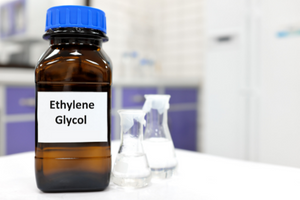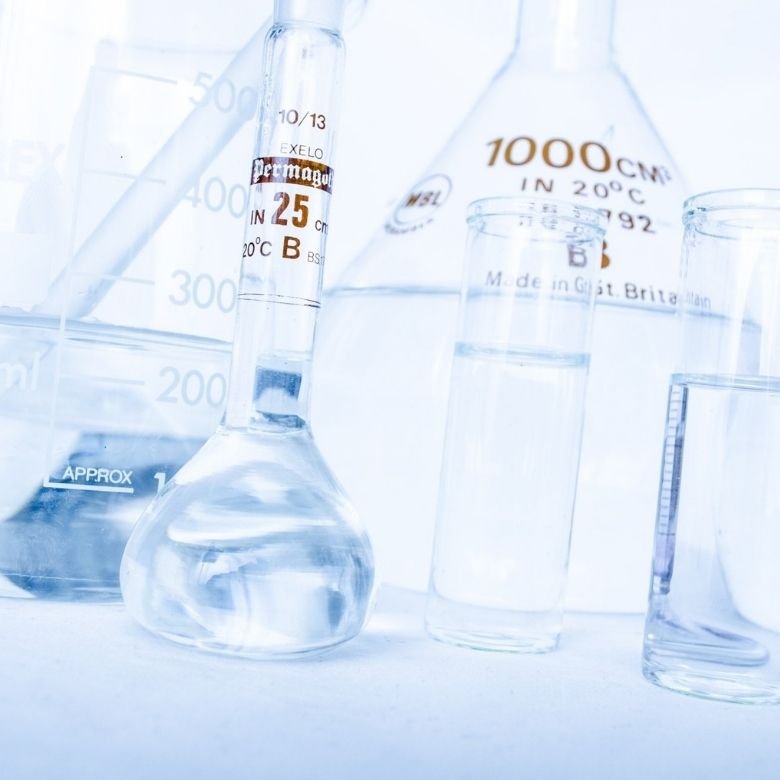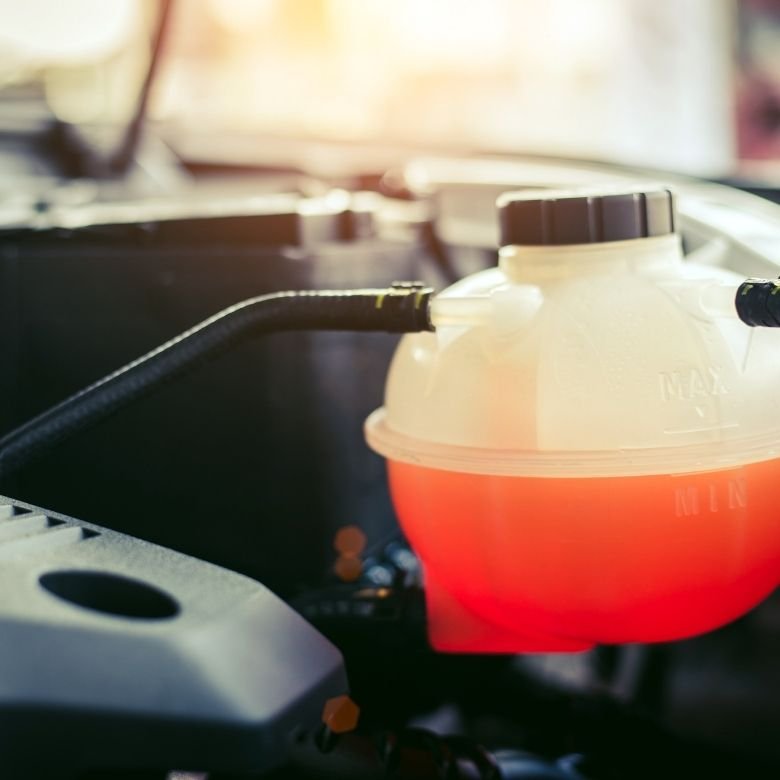Ethylene glycol, belonging to a group of compounds called glycols, is a popular refrigerants ingredient due to its excellent heat transfer properties. Glycols are used in a wide variety of heating and cooling applications such as HVAC systems, plastic mould making, food and pharmaceutical processes. Due to the widespread use of ethylene glycol in many areas, it is worth getting to know this compound and its properties better.

Physicochemical properties of ethylene glycol
Ethylene glycol with the formula CH2OH2, also known as 1,2-ethanediol, is a popular organic compound. The safety data sheet for ethylene glycol, as well as for other substances, is the primary source of information on their physical and chemical properties. Ethylene glycol is the main component of antifreeze in HVAC and automotive systems. The formula of glycol clearly indicates that it belongs to a chemical group of dihydroxy alcohols, also known as diols. Thus, glycol as an alcohol is a colourless liquid with a high viscosity and a sweet taste. In addition to its excellent miscibility with water, it is also very soluble in aldehydes, ketones and acetic acid, but it does not dissolve at all in carbon tetrachloride. It is relatively cheap to produce. Its disadvantage is crystallisation at low temperatures and lower (compared to propylene glycol) ability to absorb heat (that is about 50% of the heat capacity of water).
Ethylene glycol has a high boiling point (197ᵒC) while having a low molecular weight. This is due to the strong association of molecules in the liquid phase, caused by the formation of hydrogen bonds. In its pure form, ethylene glycol freezes at about -13°C, while the ethylene glycol: water mixture can remain liquid at much lower temperatures. A mixture of 40% water and 60% glycol, for example, can withstand temperatures down to about -37ᵒC. It should be noted that ethylene glycol is miscible with water in all proportions. This is due to the presence of two hydroxyl groups in its structure.
When browsing the literature or manufacturers’ offers, one can come across the term monoethylene glycol (MEG). However, keep in mind that monoethylene glycol and ethylene glycol are, in fact, the same substance.
Ethylene glycol – production
Ethylene glycol manufactured on an industrial scale is produced by the hydrolysis of ethylene oxide obtained in the oxidation of ethylene.
Production of ethylene oxide
In the first stage of ethylene glycol production, ethylene and oxygen are introduced into a multichannel reactor. The reaction takes place in the gas phase in the presence of silver as a catalyst based on aluminium oxide. The reaction is highly exothermic and releases large amounts of heat.
Production and purification of ethylene glycol
Ethylene oxide reacts with CO2 to form ethylene carbonate, which is then hydrolysed to ethylene glycol. Both reactions are carried out in the liquid phase using homogeneous acid catalysts. The CO2 stream from the earlier reaction steps is recycled to the ethylene carbonate reactor. The ethylene glycol is then purified in two distillation columns in which water is removed from the product. The catalyst is separated and returned to the closed-loop reactors.

Ethylene glycol and propylene glycol – basic differences
One of the major differences between ethylene glycol and propylene glycol is the level of toxicity. Ethylene glycol is toxic, and propylene glycol is not. In applications where toxicity does not matter, ethylene glycol is often the best choice for the heat transfer fluid. Ethylene glycol should not be used if it is likely to be ingested or could accidentally come into contact with food or drinking water. It should also not be used in heating or cooling systems in premises such as food processing plants or other establishments where products intended for consumption are manufactured. When low toxicity is required, propylene glycol is commonly used because of its low acute toxicity when administered orally.
Both types of glycols differ in their physical properties. Their chemical properties are also different. Ethylene glycol is widely used where performance is important, and there is no direct contact with humans or animals. Ethylene glycol has excellent heat transfer and frost protection. The low viscosity of glycol contributes to the excellent heat transfer efficiency, and the transport properties exceed propylene glycol at lower temperatures. However, since propylene glycol has a higher specific heat, it is necessary to circulate more ethylene glycol to transfer the same amount of energy as propylene glycol does. Propylene glycol solutions have a higher viscosity and pour point than ethylene glycol under the same conditions. First of all, at lower temperatures, propylene glycol is thermally less efficient than ethylene glycol.
Ethylene glycol – application
Due to the widespread use in the automotive industry, it is worth asking yourself: what is ethylene glycol and what are its uses and properties. Ethylene glycol is widely used in many industrial and commercial applications. This product also appears in a number of popular household products, such as detergents, cosmetics, paints and solvents for plastics.
Other applications of glycol are:
- production of glass fibres for products such as water scooters, bathtubs and bowling balls.
- production of ink for pens and other types of inks. Ethylene glycol increases the viscosity of the ink and reduces the likelihood of its evaporation.
- liquid heat carriers such as industrial coolants for gas compressors, heating, ventilation and air conditioning systems, as well as ice rinks. Ethylene glycol gives industrial coolants properties that help them flow through cooling systems and withstand extreme temperatures.

Ethylene glycol in coolants
Due to its properties, ethylene glycol (apart from propylene glycol) is a popular component of coolants for internal combustion engines. The main task of the coolant is to effectively collect heat energy from the engine and dissipate it through the radiator to the environment. The coolant, therefore, prevents the engine from freezing in winter and, at the same time, acts as a coolant at high temperatures in summer. In addition to the heat removal from the engine, the coolant must fulfil a number of no less important functions, such as:
- protection against freezing – ethylene glycol as a component of antifreeze agents influences improved heat transfer properties, including lower dynamic viscosity and higher thermal conductivity
- protection against cavitation – the coolant creates an effective protective layer against freezing, boiling and cavitation, preventing the formation of cavitation pits
- protection against corrosion of various elements of the engine and the entire cooling system – this can be achieved thanks to the content of synergistic corrosion inhibitors that protect metals, which are commonly used in this type of system. This helps to ensure a long service life and high thermal efficiency
- protection against the formation and deposition of impurities in the system
Ethylene glycol as a component of antifreeze agents has improved heat transfer properties, including lower dynamic viscosity and higher thermal conductivity. Ethylene glycol-based fluids can be successfully used in installations made of metals and their alloys such as copper, brass, steel, cast iron or aluminium. All common seals can be used without any problems in such cooling systems.
The future of coolants
Factors such as the increasing demand for high-performance vehicles and the increased use of high-quality high-tech additives complement the development of the global automotive antifreeze market. However, fluctuations in the prices of raw materials (crude oil) and the growing demand for electric vehicles powered by batteries somewhat inhibit the development of this sector. The availability of new environmentally friendly biotechnological refrigerants and antifreeze will surely complement the development of the automotive antifreeze market in the near future and increase the quality of those currently used.
The PCC Group offers ethylene glycol (CAS 9005-07-6). The available ethylene glycol acts as emulsifiers and lubricating oils, especially in the automotive industry. It is an excellent component for the production of coolants with special requirements.
Harmfulness of ethylene glycol
Ethylene glycol is toxic to humans and causes a number of physiological problems, including death (the Disease Control Centre estimates the lethal dose between 1,400 and 1,600 mg/kg). It is absorbed through the skin (dermal route), respiratory and gastrointestinal tracts in the human body. Consequently, ethylene glycol should not be used in applications where contamination of drinking water is possible. It should also not be used in heating or cooling systems in premises such as food processing plants or other facilities where products for consumption are manufactured.
The vapour of ethylene glycol can lead to unconsciousness, and in low concentrations, it causes irritation of the nose and throat. Much more serious are the effects of ingesting ethylene glycol. Its toxicity is mainly due to the accumulation of toxic metabolites. Ethylene glycol has a strong effect on the central nervous system (CNS). It has an acute effect similar to that of ethanol. This effect on the central nervous system prevails in the first hours after exposure. The undiagnosed or untreated intake of ethylene glycol can lead to severe bodily injury and even death.

Ethylene glycol – FAQ
- Can ethylene glycol be mixed with propylene glycol?
The answer to this question is sought by every car owner who wonders whether it is possible to mix coolants based on different glycols. It shouldn’t be done. In the case of ethylene glycol and propylene glycol, the main difference is the density of these substances. In practice, it is difficult to measure the frost resistance of the fluid, and this can result in trouble during the winter season.
- How to distinguish ethylene glycol from propylene glycol?
There is a method available to distinguish these two glycols. It uses differences in physical properties, specific density, and the refractive index between ethylene and propylene glycol. The latter is a very helpful parameter in determining which relationship we are dealing with. A few drops of the substance are placed on the prism of a special device, a so-called refractometer and reads the refractive index that enables identification.
- How is ethylene glycol different from glycerol?
Both compounds belong to the same chemical group, i.e. alcohols. They differ in the amount of -OH hydroxyl groups in the molecule. Glycerol is a derivative of propane (propanetriol), while ethylene glycol is a derivative of ethane (ethanediol). In aqueous solutions, they lower the freezing point and also increase the boiling point. Having a choice of glycerol and ethylene glycol, it is worth considering the use of the former because it is safer to use. Its negative impact on the environment is also smaller.
- Where can ethylene glycol be bought?
Ethylene glycol can be easily bought in chemical stores or wholesalers. The price of this substance is in a relatively wide range. It is worth paying attention to purchasing goods of the highest quality. Ethylene glycol is also included in the range of reagents offered by the PCC Group (CAS number 9005-07-6).
- Ethylene glycol poisoning – what are the symptoms?
Ethylene glycol poisoning very often resembles the state of alcohol intoxication. There is a noticeable incoherence of movements, drowsiness, rapid breathing, increased blood pressure and, in some cases, convulsions. Ethylene glycol poisoning cannot be underestimated. After 24 hours, the first symptoms of renal failure appear. Poisoning causes circulatory failure and even serious damage to the central nervous system.
- How to distinguish ethylene glycol from glucose?
We can distinguish these two compounds by performing the popular Trommer test. Glucose belongs to the so-called aldoses, which in turn are classified as aldehydes. Aldehydes are known to pass the Trommer test, while diols (e.g. ethylene glycol) do not pass it. The whole experiment is based on the reduction (using the tested substance) of blue-coloured copper (II) hydroxide CuOH2 to brick-coloured copper (I) oxide Cu2O in an alkaline environment.
- https://echa.europa.eu/pl/information-on-chemicals/cl-inventory-database/-/discli/details/53082
- https://pubchem.ncbi.nlm.nih.gov/compound/Ethylene-Glycol
- https://medpr.imp.lodz.pl/Etery-glikolu-etylenowego-i-glikolu-propylenowego-toksycznosc-reprodukcyjna-i-rozwojowa,59135,0,2.html